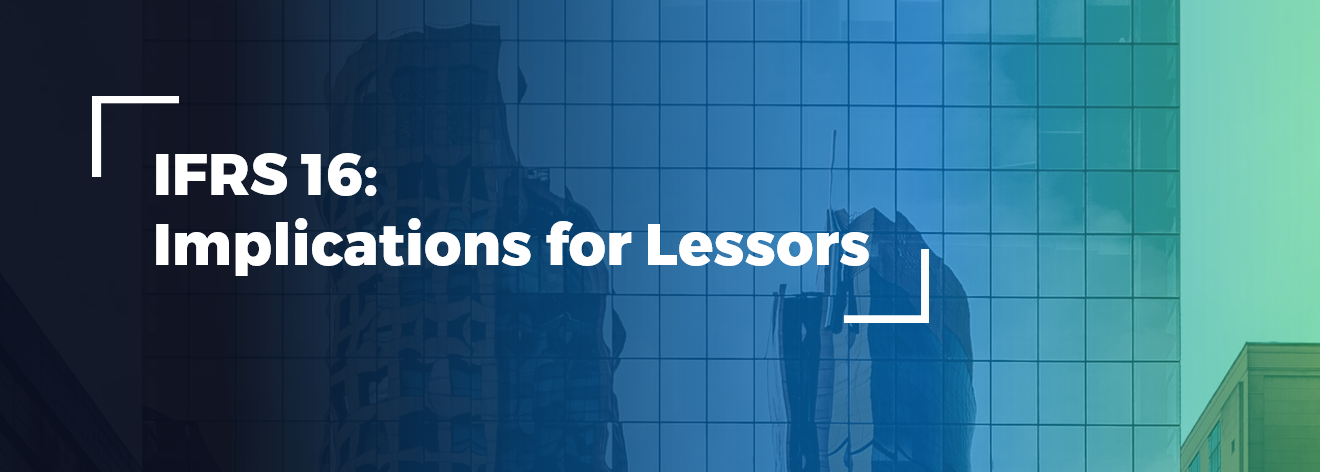BLOGS
IFRS 16 – Implications for Lessors

Published back in 2016 the new lease accounting standard IFRS 16 ‘Leases’, is effective for all annual reporting periods beginning on or after 1 January 2019.
For lessees, compliance with the new standard entails considerable work, expense and impact on their financial statements but, happily for lessors, the practice of lease accounting remains substantially the same as the guidance under IAS 17.
Whilst lessees will be engaged in reclassifying any operating leasing, with the odd exception as finance leases, lessors are still required to classify leases as either finance or operating, and the indicators used to make that distinction remain unchanged from IAS 17.
During the drafting of the new accounting standards by the FASB and IASB, the lobbying of the lessor community was successful in its main aim of limited and minimal change in lessor accounting. The lessor approach of “why try and fix something that’s not broken”, was persuasive and ultimately heeded by the accounting standards bodies.
For lessors, the template of lease accounting is materially the same as under IAS 17 in that lessors continue to classify leases as finance and operating leases in a similar manner under IFRS 16 with the same lease classification criteria. Leases that transfer substantially all the risks and rewards incidental to ownership of the underlying asset are finance leases; all other leases are operating leases.
It is no secret and patently obvious that this accounting model is inconsistent with the accounting model to be applied by lessees – lessees follow the new single rather than dual lease accounting model. Going forward, in the case of an operating lease, the lessee will recognise a financial liability for its obligation to make fixed-lease payments, but the lessor will not recognise a financial asset for its right to receive those lease payments. This has potential implications for lease structures such as sub-leases or intermediary leases.
Remember the lessor’s classification of any lease remains subject to that same mantra – “substance over form”. Whilst that IAS 17 guideline “you have a finance lease if substantially all of the risks and rewards incidental to ownership of the leased asset have been transferred to the lessee, otherwise you have an operating lease”, IFRS 16, paragraph 63 gives assistance where judgements need to be made.
For any operating lease, the lessor will continue to recognise on its balance sheet the underlying asset or assets subject to the lease contract.
For a finance lease, the lessor recognises a receivable at an amount equal to the net investment in the lease; this is the present value of the aggregate of lease payments receivable by the lessor and any unguaranteed residual value.
Along with the sub-lease issues, inevitably and perhaps unsurprisingly there are other implications for lessors and not just for lessees in the adoption of the new lease accounting standard IFRS 16. As well as revised definitions relating to just what comprises a lease and the introduction of the term a “right of use asset”, the ‘Lease term’ is defined and applies for both lessees and lessors in the same way (taking into account any extension or termination options when determining the length of the lease term). Looking at these, in turn, we have perhaps five areas of impact.
1. Subleases
IFRS 16 requires an intermediate lessor (the lessee of that asset but now the sub-lessor) to classify the sublease as a finance lease or an operating lease in a defined manner - if the head lease is a short-term lease that the entity, as a lessee, has accounted for by recognising the lease payments as an expense on a straight-line basis over the term of the lease, the sublease must be classified as an operating lease. Otherwise, the sublease must be classified by reference to the right-of-use asset arising from the head lease, rather than by reference to the economic useful life of the underlying asset (such as the item of property, plant or equipment that is the subject of the lease). Therefore, where the head lease is not a short-term lease expensed on a straight-line basis over the lease term, the lessor must use the general principles (and the associated examples and indicators) for classification of a lease as an operating or a finance lease (as outlined above) by reference to the right-of-use asset.
2. Separating out non-lease components from a lease contract
“Lease” agreements may cover more than one type of obligation with a combination of lease components, or of lease and non-lease components. Lease contracts covering property as the asset often require the lessee to indemnify the lessor for certain costs and to reimburse the lessor for others related to the leased property. Examples might include insurance, property taxes and common area maintenance provided by the lessor. Under IFRS 16 each separate lease component must be identified and accounted for separately. When identifying non-lease components, an entity must consider whether a good or service is transferred to the lessee. [IFRS 16 para B33]. The lease and non-lease components having been identified, the consideration within the contract must then be allocated. Using the stand-alone selling prices of the components, lessors must allocate consideration in accordance with IFRS 15. The consideration is only allocated to identified lease and non-lease components. Where there are other costs associated with the agreement, but these are not a separate component, no consideration is allocated to them.
3. Lease payments
Essentially comprising 5 different income components with which to measure the net investment in any lease we have:
- Fixed payments.
- Variable payments – rentals dependent on an index or a rate.
- Residual guarantees underwritten by the lessee
- Purchase price option (where considered likely to be exercised)
- Penalties payable for termination of the lease
To measure the net investment in the lease (and therefore its assets), the lessor must use the interest rate implicit in the lease. Subsequent to initial recognition, a lessor must recognise finance income over the lease term, based on a pattern reflecting a constant periodic rate of return on the lessor’s net investment in the lease using the defined amortised cost method.
Lease receivables must be treated in accordance with the new impairment requirements for financial assets included in IFRS 9 Financial Instruments.
4. Lease modifications
This is where IFRS 16 comes into its own for lessors. Where IAS 17 provided no guidance on treatment by lessors, IFRS 16 documents the usual and accepted practice of most lessors with regard to modifications to operating leases. It does, for instance, set out the treatment for operating leases where they might need to be reclassified as a finance lease. Likewise, where an extension to an operating lease does not change its status then the treatment of future payments is set out – in this case as straight-line over the new remaining period.
Sale and leaseback transactions
From the perspective of the seller of the assets (that is the lessee’s position), IAS 17 went to some detail outlining the accounting treatment of sale and leaseback - that is the entity that was the seller of the assets. This transaction type has over the years proved very attractive for businesses seeking long term funding. Cash can be realised from substantial property, plant or equipment ownership transfer. Under the new accounting standards, the lessor (or buyer) accounts for the purchase in accordance with the applicable standards (IAS 16 ‘Property, Plant and Equipment’ but IAS 40 where the purchase is of investment property). Assuming the sale and purchase reflect market rates then the lease is then accounted for by the lessor (buyer) as either an operating or finance lease using IFRS 16’s lessor accounting requirements. If fair market value is not the buy price or if the rental is other than a market rate, then adjustments must be made to reflect any additional financing made available by the lessor or any prepayments made to justify the below-market terms.
Summarising the effect on Lessors
From an accounting perspective, we have identified that IFRS 16 does impact lessors. The standards set out new definitions and guidance regarding a lease, lease term and lease payment, separation of components, subleases and the accounting for sale and leaseback transactions.
However, the impact on lessees may have an indirect impact on lessors in that off balance operating leases as a driver for contract negotiations may now be replaced with a desire to understand if a lease transaction for this negotiation exists at all.
Other negotiation points might include variable lease payments which could be excluded from the lease liability or inclusion of termination options which might minimise the lease term. As such, the standard might have an impact that extends beyond the accounting treatment.
Finally, whilst many lessors have, quite understandably, concluded that the adoption of IFRS 16 will not impact them, where an entity is a lessor in a sublease arrangement, IFRS 16 does create complexity in accounting for the lease. As part of their process of adopting IFRS 16, finance teams, particularly those of businesses ordinarily lessees should identify all leases in which they are the intermediate lessor and determine how each particular “sub-lease” will be classified - finance lease or operating lease, and what the applicable accounting treatment will be.
Disclaimer: this article contains general information about the new lease accounting standards only and should NOT be viewed in any way as professional advice or service. The Publisher will not be responsible for any losses or damages of any kind incurred by the reader whether directly or indirectly arising from the use of the information found within this article.









